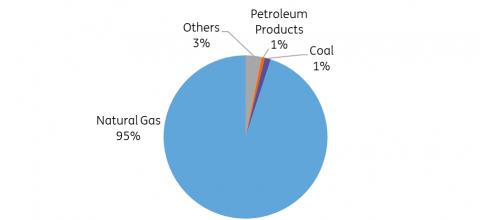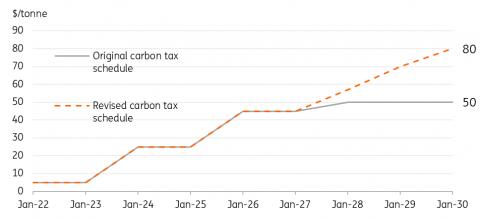(MENAFN- ING) Singapore's climate goal: Net-zero by or around mid-century
Singapore recently announced a revised ambition to achieve net zero emissions by or around mid-century .
What it's been doing to get there
Singapore unveiled the Singapore Green Plan 2030 in 2021 and recently raised its ambition to achieve net-zero emissions by or around mid-century . Singapore is currently consulting with industry and stakeholder groups and will finalise its plans before official changes are made to its previously-submitted Long-term Low Emissions Development Strategy (LEDS).
Singapore Green Plan 2030
Singapore announced the Green Plan 2030 (GP2030) in 2021, focusing on five pillars (city in nature, sustainable living, energy reset, green economy and resilient future) each with specific targets by 2025/26 and 2030. GP2030, which is viewed as a nationwide effort to pursue sustainability goals, involves five ministries and looks to strengthen existing efforts and set additional targets.
Some examples of 2030 targets are to plant one million trees (city in nature), expand the rail network to 360km from 230km (sustainable living), target 60,000 electric vehicle charging stations (energy reset), promote Singapore as a sustainable tourist destination (green economy), and meet 30% of Singapore's nutritional needs through locally produced food (resilient future).
Reducing emissions derived from power generation
Singapore aims to lower carbon emissions by reducing emissions derived from power generation. Over the past few years, Singapore has been able to decrease its reliance on petroleum-based power generation while shifting to power plants driven by natural gas. Singapore considers natural gas as the fossil fuel with the lowest emissions and natural gas accounts for 95% of Singapore's power generation capacity, down from only 18% back in 2000 .
On top of the shift to natural gas, Singapore has also identified solar-based power generation as a key renewable source given the country's designation as alternative energy disadvantaged. Singapore aims to install up to 2 GWp to power roughly 350,000 households. However, given Singapore's limited land area, achieving this 2030 aspirational goal of 2 Gwp would generate only 3% of the projected 2030 demand.
Given the constraints faced in generating renewable energy (RE), such as limited land area, low wind speeds, and a lack of geothermal resources, Singapore has resorted to importing power generated by RE sources. In 2014, Singapore signed the Lao PDR-Thailand-Malaysia-Singapore Power Integration Project (LTMS-PIP) with Singapore recently sourcing hydroelectric power from Lao PDR via Thailand and Malaysia. Access to the regional power grid allows Singapore to work around existing geographical impediments to RE generation while still working to lower emissions from power used in the country.
Singapore power generation by source (2021)

Singapore Energy Market Authority
Developing low carbon technology
Singapore also aims to lower emissions by developing low carbon technology across several aspects of the economy. The country's current US$5/tonne carbon tax, the first to be implemented in the region, began in 2019 under the Carbon Pricing Act, to incentivise the shift to emissions reduction.
Singapore also allocated an SGD25bn budget for the Research Innovation Enterprise RIE2025, which alongside GP2030, will push firms to establish research activities related to sustainable development.
Both budgetary support and price incentives will be key to attaining the various targets set by GP2030 and Singapore's overall goal to achieve net-zero emissions by mid-century.
Green Finance action plan
In 2019, Monetary Authority Singapore (MAS) launched the Green Finance Action Plan to make Singapore a leading global centre for green finance. In 2020, MAS issued papers on the proposed guidelines on environmental risk management to help strengthen the financial sector's role in supporting the transition to an environmentally sustainable economy.
What's happened since the Ukraine war
More ambitious carbon tax plans
Given the recent developments surrounding the Russia-Ukraine war, Singapore has decided to push ahead and set a more ambitious carbon tax timeline, currently now $5/tonne, to $25/tonne by 2024/2025, $45/tonne by 2026/2027 and reaching $50 to $80/tonne by 2030.
Now open to nuclear?
Previously, Singapore had ruled out nuclear energy as a potential RE option during the submission of its revised Nationally Determined Contribution (NDC) to the UN, indicating that the risks associated with nuclear energy outweigh the potential benefits. The Ukraine war and the resulting surge in commodity prices have sparked renewed interest in nuclear energy with the Energy Market Authority (EMA) indicating that it would continue to monitor areas such as nuclear energy and their implications for Singapore. Improved technology may be the key for nuclear energy to be utilised in Singapore as now available small modular reactors could address concerns about Singapore's limited land area and population density.
No subsidies
Surging commodity prices and the impact on petrol and diesel prices fuelled calls for Singapore to either reduce or suspend duties to help lower prices. Finance minister Lawrence Wong rejected these calls, indicating that such a move would effectively subsidise higher-income households given that only four in 10 households own cars. Instead, just like in the Philippines, Singapore opted to retain existing duties on fuel while rolling out a support package targeted at lower-income households.
Net zero emissions by 2050 in the power sector
Singapore's EMA recently published Charting The Energy Transition to 2050, the Energy 2050 committee's report indicating its findings and recommendations on how Singapore can lower carbon emissions in the power sector. The report also suggests that Singapore can achieve net-zero emissions in the power sector by 2050 by developing new sources of energy (hydrogen), importing renewable energy from the regional power grid, and maximising solar power use.
Singapore chasing more ambitious carbon tax targets

Singapore Budget 2022
Conclusion
The ongoing conflict in Ukraine has not slowed down Singapore's push toward its sustainability goals so far. One example would be Singapore opting to chase more ambitious carbon tax goals, unlike neighbouring Indonesia which chose to delay its targets.
Meanwhile, the high price environment for energy has heightened calls for Singapore to consider other RE options (nuclear and hydrogen) and chase net-zero emissions in power by 2050.
Lastly, despite the clamour for the removal of duties on petrol and diesel, authorities cited the need to preserve the incentive for car owners to shift to energy-efficient modes of transportation or purchase low-emissions vehicles.
Thus, the war in Ukraine appears to have helped push Singapore's efforts to attain its sustainability goals so far.
MENAFN01082022000222011065ID1104627251
Author:
Nicholas Mapa
*Content Disclaimer:
This publication has been prepared by ING solely for information purposes irrespective of a particular user's means, financial situation or investment objectives. The information does not constitute investment recommendation, and nor is it investment, legal or tax advice or an offer or solicitation to purchase or sell any financial instrument. Read more here: https://think.ing.com/about/disclaimer/
Legal Disclaimer:
MENAFN provides the information “as is” without warranty of any kind. We do not accept any responsibility or liability for the accuracy, content, images, videos, licenses, completeness, legality, or reliability of the information contained in this article. If you have any complaints or copyright issues related to this article, kindly contact the provider above.